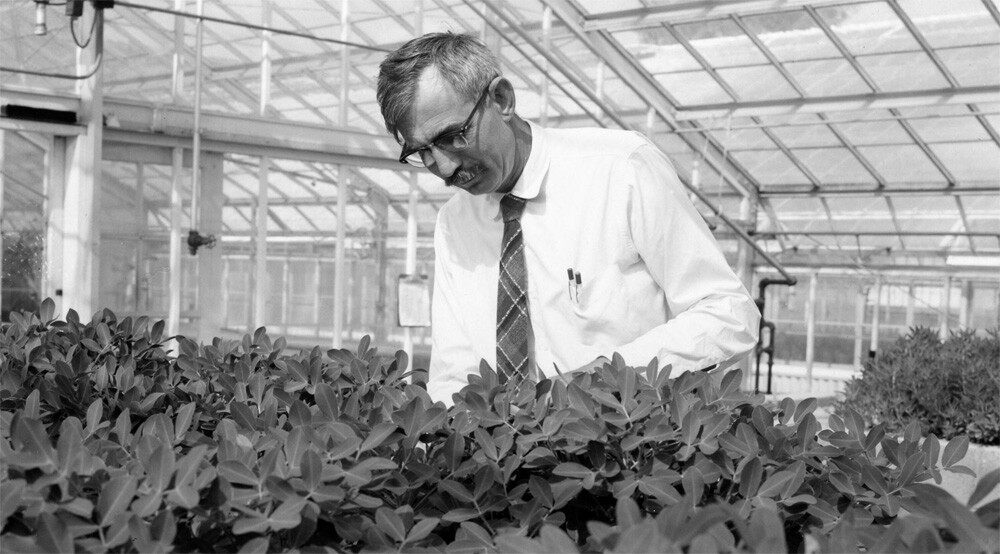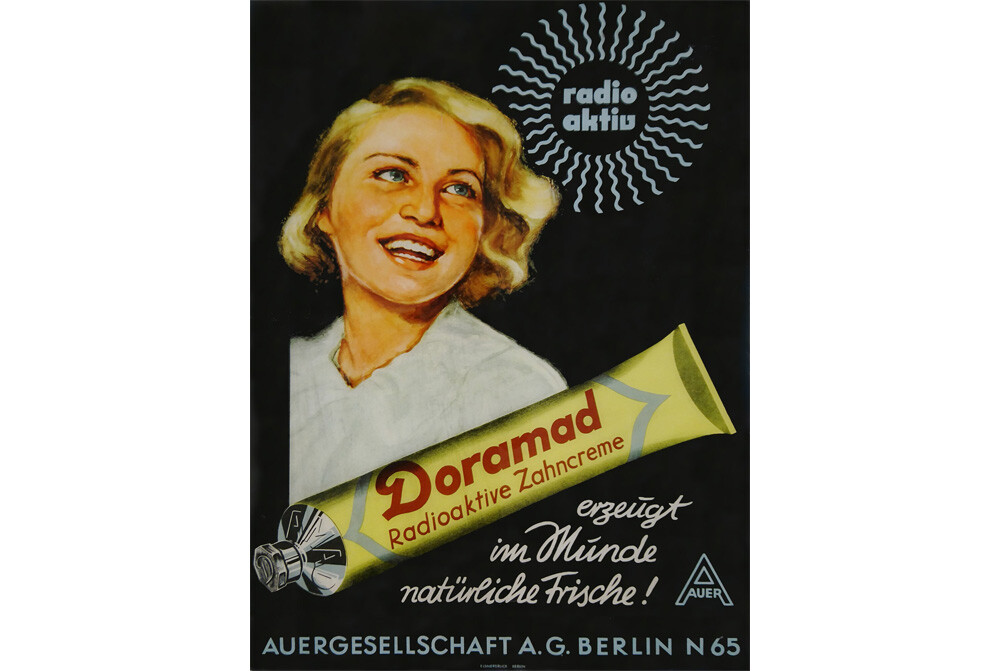'Atomic Gardening' Is A Real Thing (And We're Still Doing It)

"Atomic gardening" sounds about as real as "quantum bucket," "electron mop," or whatever other mishmash of scientific terms and ordinary words that characters in a Heinlein novel would throw around after their daily fivesome. But it's actually a real form of agriculture where crops are exposed to a radioactive source to create potentially beneficial mutations like larger sizes or immunity to diseases, and the reason why the term sounds so old-timey is because it's not a new idea at all. Humanity has been atomic-gardening for over 100 years now, and there's a very good chance that you've eaten the literal fruits of those labors without ever knowing it.
Atomic Gardening Was Created To Save The World
In the 1920s, scientists started X-raying barley because in those days the only time people weren't shotgunning double whiskeys was when they were doing cocaine. This led to an interesting discovery that a sufficiently high enough dose of X-ray radiation could create inheritable mutations in the crop, thus laying the foundation for serious atomic gardening, which developed during the 1950s.
Don't Miss
After scientists developed the atom bomb, they started looking for ways to come to terms with the fact that they were responsible for creating a weapon that could quite literally destroy the world. And because therapy hadn't been invented yet, they settled on finding non-destructive uses of radiation. This eventually resulted in an idea, pioneered by the Brookhaven National Laboratories in Rhode Island, of exposing plants to cobalt-60 and seeing what happened. The radioactive material would be placed in the middle of an atomic garden patch, with strawberries, sugar maples, corn etc. being planted around it like slices of a pie. Hang on, let's see if we can find a helpful visual ...

via Wiki Commons
Once the flora took a long enough shower in Godzilla's morning breath, scientists wearing full radiation suits would come in an inspect the results. The plants nearest the cobalt-60 would usually just be dead. The ones in the middle merely begged for death (which we may or may not mean literally) because of their massive tumors and other gruesome mutations. But the ones near the back -- those were the ones that got their genome scrambled just enough to basically get superpowers. We're talking about larger sizes, better taste, and resistance to illness etc., all of which were inheritable, like with Todd Mitchum Peppermint or the Rio Star Grapefruit.
Just so we're clear: although the plants and their seeds were irradiated does not mean that they were radioactive. They were mutated via radiation, but they didn't emit radiation themselves. The cultivars were and still are perfectly safe. Hell, the Rio Star Grapefruit has been around for over 50 or so years now and actually accounts for 75% of Texas' grapefruit production. Trust us, if atomic gardening could result in you growing extra limbs, Amazon would've used it to create a race of bladder-less Machamps that could pack boxes twice as fast and spray sticky diarrhea whenever they heard the word "union."
It Was Popularized Thanks To A Lady Getting A Giant Nut ... And L. Ron Hubbard
The initial success of the Brookhaven experiments gave scientists hope that radiation might be the key to stopping world hunger, and soon atomic gardens were created all over the world, from the US to Costa Rica, Sweden, and Japan. But the practice didn't really enter popular culture until a guy showed his massive nuts to his lady friend.

In 1958, Dr. Walton C. Gregory of North Carolina State University exposed 200lbs of peanuts to a massive amount of radiation and planted their seeds. One of the resulting crops produced peanut seeds the size of almonds, which Gregory then sent as a gift to his friend Muriel Howorth. Howorth was apparently a big fan of all things atomic (which is why you always had to make sure your underwear wasn't sticking out of your pants around her) and she loved these "NC4X" peanuts so much, she served them during a dinner at the Royal Commonwealth Society in London. And none of her guests apparently gave a crap.
While Howorth was reacting to the peanuts like your dad does to an obviously photoshopped picture of a guy posing with a giant fish he "caught" (i.e. going berserk and asking people "can you believe this shit?!") everyone else was unenthused. Most didn't even want to try them. Instead of cupping herself and going "How about you suck on deez nuts then," Howorth decided to do the most British thing ever and blow off some steam via gardening. She planted the peanuts, which germinated in just four days and grew 2 feet high. The plant created a media frenzy.

Soon there were newspaper and TV interviews, book deals, speeches. Howorth used her newfound fame to create the Atomic Gardening Society, and invited scientists from all over the world to help her promote atomic gardening as a viable form of agriculture. One of the society's "scientific advisers" was the self-proclaimed nuclear scientist, author of All About Radiation (1957), and the founder of Scientology: L. Ron Hubbard. Although Hubbard was as much a real scientist as Dr. Dre is a real doctor (among other things, his book claimed that you could actually cure radiation poisoning with vitamins), the man was pretty well known, and his involvement did help bring atomic gardening into the spotlight so ... thanks? We guess? Maybe?
It Became A Nationwide DIY Hobby In The US
One of the goals of the Atomic Gardening Society was getting regular people involved in atom-blasting plants like they were Fallout sex-droids, which OF COURSE would be so EASY. Because any Joe Schmo could get his hands on RADIOACTIVE MATERIAL half a century ago! You could just WRITE the US government and they would SEND YOU a crate of cobalt-60! Sorry, our Caps Lock key is malfunctioning, so you might have gotten the wrong impressions that we were being sarcastic but, no, in the mid-20th century, getting cobalt-60 was pretty easy.

In 1957, a man by the name of Clarence Speas petitioned the Atomic Energy Commission to let him have some comic book superhero starter kit and they were like "Yeah, sure, whatever." In 1960, he founded the Oak Ridge Atom Industries, Inc., which consisted of the concrete bunker behind his house where he used to irradiate seeds and sell them in packets to anyone who wanted to play around with atomic gardening. Again, the seeds were perfectly safe, but let's take a moment to appreciate the fact that a random Tennessee dentist (cause, yeah, Speas wasn't a scientist or anything) was selling "atom-blasted" mutant seeds in the mail, and then let's lament that this still isn't a movie. How about a shoutout in one of your comics, Marvel or DC? THIS IDEA IS FREE, FFS.
Anyway, a lot of people bought the seeds. Howorth and her Atomic Gardening Society are said to have bought over 3.5 million seeds from Speas and distributed them on the other side of the planet. The seed recipients were supposed to document any interesting mutations that occurred in their atom-blasted lettuce, radishes, peppers, green beans, poppies, petunias, and a bunch of other plants. There were even amateur atomic gardening shows and exhibitions. Speas-inspired irradiated seeds even appeared as a plot device on an episode of Gilligan's Island. That's how popular this whole thing was. Essentially, the ‘50s and ‘60s were like a reverse X-Men comic with the whole world falling in love with mutants. This was to be expected, though:
All Of This Was The Logical Result Of Global Atomic Positivism
Pretty much since we first discovered radioactive materials, humanity was all like "Oh HELL yeah, put this cool glowy thing RIGHT INSIDE ME!" That's not even an exaggeration. For example, between the 1920s and the end of WW2, there was a German company called Auergesellschaft which produced radioactive toothpaste. It contained small amounts of thorium, which, according to the advertising, killed germs and improved the circulation in your gums. Your skull glowing ominously in the dark through your skin meant that it was working!

via Wiki Commons
Actually, the toothpaste only emitted very small amounts of 4-MeV alpha particles, and apparently wasn't that dangerous. No such luck with radium dials, sadly.
In the early 20th century, watches, clocks and other instrument dials covered in glowing paint containing radium-226 were all the rage in the US. There were three companies producing them: the United States Radium Corporation, the Radium Dial Company, and the Cold Light Manufacturing Company, and they all employed young women to paint their dials. This was very delicate and precise work, and in order to shape the point of their brushes, the girls would lick them. They would lick the same brushes that they later dipped in radium. They put radium-dipped brushes in their mouths. This resulted in a terrible condition known as radium jaw or radium necrosis, which you should not Google. Trust us. Learn from our mistakes.

The survivors of the radium dial plants, the so-called Radium Girls, eventually sued their companies and won better working conditions, but the incident did little to tamper rising atomic positivism. Atomic gardening was just the logical progression of the world's bizarre fascination with all things radioactive and nuclear. And, look, this is not a dig at nuclear energy. That's a whole other thing where the pros basically outweigh the cons. No, when we say the world had a bizarre fascination with the power of the atom, we mean it, on account of some people once seriously considering nuking Alaska to create a new harbor. Fortunately, we finally stopped trying to make the Earth glow in the dark after one scientist found just a bunch of strontium-90 (a carcinogenic isotope) ... in baby teeth.
Honestly, compared to all of that, atomic gardening sounds boringly safe and makes a lot of sense. So much so that ...
Atomic Gardening Has Continued To This Day
By 1962, we've managed to create about nine mutant cultivars using atomic gardening. By 2008, that number rose to 2,700 varieties because atomic gardening never really went away. The UN is a huge believer in it, having its Food and Agriculture Organization work closely with the International Atomic Energy Agency and Japan's Institute of Radiation Breeding to create new varieties of plants by putting their genomes in radioactive cocktail shakers.
New atomic gardens are being constructed all the time, though most of them in developing nations like Bangladesh, Ghana, or Sudan. The UN does not exactly advertise this because a Western organization starting radioactive mutant farms in impoverished countries maybe does not have the best optics. Still, people like Dr. Pierre Lagoda at the International Atomic Energy Agency claim that the atomic gardens already produced a lot of exciting results like, say, "a virus-resistant cocoa tree in Ghana ... and a high-yielding rice for the Mekong Delta."

via Wiki Commons
Again, produce cultivated in atomic gardens is perfectly safe, and it's not limited today to developing nations. All sorts of gamma-breeding cultivars have already made their way into our food supply, from variants of wheat, soybeans, rye, and many more. Like we said earlier, there is a very good chance you've eaten the results of atomic gardening, and yet you still look ridiculous in spandex and a cape. Atomic gardening is here to stay, and if we just give scientists the benefit of the doubt, plus some time, they may finally develop an apple that tastes just like pizza, so relax and don't screw the Pizzapple for us with your paranoid luddite bullshit.
Follow Cezary on Twitter.